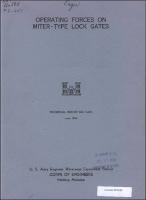Please use this identifier to cite or link to this item:
https://hdl.handle.net/11681/4728| Title: | Operating forces on miter-type lock gates |
| Authors: | U.S. Army Engineer Waterways Experiment Station |
| Keywords: | Hydraulic gates Lock gates Locks Hydraulic structures Kinematics Operating machinery Miter gate Hydraulic resistance Operating forces Torque |
| Publisher: | U.S. Army Engineer Waterways Experiment Station |
| Series/Report no.: | Technical report (U.S. Army Engineer Waterways Experiment Station) ; no. 2-651. |
| Abstract: | Tests to determine operating forces on miter-type lock gates were conducted in a 5.5-ft-wide, 66.5-ft-long, 4.25- ft-deep flume equipped with a single set of miter gate leaves located approximately in the center of the flume. Three linkages, with different kinematics of the operating machinery, were studied: modified Ohio River, Panama, and Ohio River. For each linkage, tests were conducted at gate submergences of 1 to 4 ft and at operating times of 10.1 to 40.2 sec. The effects of chamber length, bottom clearance of gates, presence of barges in the lock chamber, and nonsynchronous operation of the gate leaves also were investigated. Peak hydraulic resistance to operation of the miter gate was observed as the leaves entered and left the mitered (closed) position with the maximum resistance occurring as the leaves entered the mitered position. (Peak torques were actually observed as the leaves left the recesses (began closing) with the Ohio River and modified Ohio River linkages, but these torques were created by sudden application of loads to the rigid model linkages and thus were not considered representative of those of prototype gates which are equipped with shock absorbers.) The modified Ohio River and Panama linkages resulted in peak resistances in terms of torque at the pintles which were approximately equal and about 40 percent less than the peak torques obtained with the Ohio River linkage. Other general findings were: (A.) An increase in submergence of the gate leaves or speed of operation resulted in increased hydraulic resistance. (B.) Hydraulic resistance increased as the bottom clearance of the gate leaves was decreased. (C.) Hydraulic resistance decreased as the length of the lock chamber was increased. (D.) Nonsynchronous operation of the gate leaves resulted in a slight reduction in peak torque. (E.) Limited tests conducted with barges in the lock chamber showed no appreciable effect of a tow in the chamber on torque values. (F.) Although only limited field test data are available, the peak torques observed on prototype miter gates utilizing the modified Ohio River linkage compare favorably with those observed on the model gates. (G.) Peak torques observed in model tests of the Panama linkage by the Special Engineering Division of the Panama Canal (see Appendix A) occurred during the opening cycle whereas peak torques were observed during the closing cycle in the WES model tests. However, the maximum torque value predicted from the WES tests on the basis of average angular velocity of gate travel, for equal submergence and operating time, compares favorably with that predicted from the Panama Canal tests. |
| Description: | Technical Report |
| Gov't Doc #: | Technical Report No.2-651 |
| Rights: | Approved for public release; distribution is unlimited. |
| URI: | http://hdl.handle.net/11681/4728 |
| Appears in Collections: | Technical Report |
Files in This Item:
| File | Description | Size | Format | |
|---|---|---|---|---|
| Technical-Report-No-2-651.pdf | 11.77 MB | Adobe PDF |  View/Open |